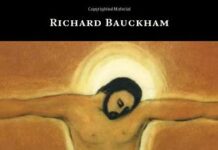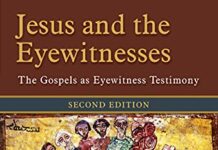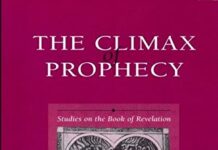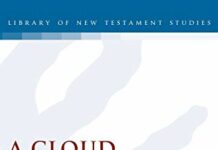
Ebook Info
- Published: 1993
- Number of pages: 188 pages
- Format: PDF
- File Size: 7.91 MB
- Authors: Richard Bauckham
Description
The Book of Revelation is a work of profound theology. But its literary form makes it impenetrable to many modern readers and open to all kinds of misinterpretations. Richard Bauckham explains how the book’s imagery conveyed meaning in its original context and how the book’s theology is inseparable from its literary structure and composition. Revelation is seen to offer not an esoteric and encoded forecast of historical events but rather a theocentric vision of the coming of God’s universal kingdom, contextualised in the late first-century world dominated by Roman power and ideology. It calls on Christians to confront the political idolatries of the time and to participate in God’s purpose of gathering all the nations into his kingdom. Once Revelation is properly grounded in its original context it is seen to transcend that context and speak to the contemporary church. This study concludes by highlighting Revelation’s continuing relevance for today.
User’s Reviews
Reviews from Amazon users which were colected at the time this book was published on the website:
⭐CHAP 1: BACKGROUNDThe author, John, is taken up into heaven to see what is really going on in his current time period, and later, given a vision of the end of the world.John’s readers are Jews living under Roman rule. The righteous suffer, the wicked prosper. The world seems to be ruled by evil, not by God. John’s visions show them that, despite appearances, it is God who rules. The time is coming when He will overthrow the evil empires and establish His kingdom.John writes a letter of apocalyptic prophecy to seven churches in Asia, and to “whoever has ears” (2:11). He encourages each of them to be victorious, as they are part of God’s cosmic battle against evil.IMAGERY1. First century readers were constantly bombarded with Roman imperial power. For example, In Rev 17, John’s readers share his vision of a woman. At first glance she might be the goddess Roma, a stunning personification of the civilization of Rome, as she was worshiped in many city temples in Asia. But John sees her as a Roman prostitute, a seductive whore and a scheming witch. Her wealth and splendor represent the profits of her disreputable trade. In this way, John’s readers are able to perceive the moral corruption of Rome’s true character.2. Revelation is saturated with verbal allusions to the Old Testament.3. Revelation also echoes first century mythological images, like the serpent or dragon representing the source of evil in the world, the devil.Misunderstanding of this imagery and its meaning accounts for many misinterpretations of Revelation.CHAP 2: THE ONE WHO IS AND WHO WAS AND WHO IS TO COME (1:4, etc)Quite like the New Testament greetings that comfortably include Jesus in the divine.This is a Trinitarian greeting.The Father = “Him who is and who was and who is to come”The Son = Jesus Christ, the faithful witness, the firstborn from the dead, and the ruler of the kings of the earth”The Spirit = “the seven Spirits who are before His throne” (see Chap 5 for explanation)GOD and JESUS ARE…1. “the Alpha and the Omega”Both God (1:8; 21:6) and Christ (1:17; 22:13) call themselves “the Alpha and the Omega,” “the first and the last”, and the beginning and the end.”This comes from Isaiah 44:6 where God magnificently asserts Himself over the idols of Babylon. Here He announces His complete sovereignty over all, first before John’s vision, and last, in declaring the completion of His purpose, “It is done!” (21:6).2. “the One who is and who was and who is to come” refers to the divine name YHWH in Ex 3:14.”I AM” = ’ehye, or “I will be who I will be” = ’ehye ’ăšer ’ehye. The God who will bring all things to fulfillment.3. “the Lord God the Almighty” (1:8; etc). The Greek “pantokrator” (Almighty) means the God who is in control of all things.4. “the One who sits on the throne” (4:9, etc).John’s vision of Christ on His throne enables his readers to view their own situation in the context of God’s great plan to overcome opposition to His rule and establish His kingdom in this world.This aligns with the visions of God’s throne in Isaiah 6 and Ezekiel 1.All that is said of God’s ineffable appearance is that it was like precious stones (4:3). Emphasis is put upon the continuous worship of Him upon the throne, who is “holy, holy, holy” and “worthy to receive glory and honor and power” (4:8,11).THE CONCENTRIC WORSHIP AROUND GOD’S THRONEFirst, with the “four living creatures,” who combine Isaiah’s seraphim (Isa 6:2) and Ezekiel’s cherubim (Ezek 1:5-14). They were represented by the two cherubim who flanked the mercy-seat on the ark of the covenant (Ex 25:18-22). They exist solely to worship God continually.Each has a different face: human, lion, ox and eagle. They have six wings and myriad eyes.Second, the “twenty-four elders” (not specifically identified). The author says they rule the heavenly world on God’s behalf. They “will cast their crowns before the throne” indicates that only God should be worshiped, not human kings (4:10).Third, “the voice of many angels around the throne…myriads of myriads, and thousands of thousands” (5:11).Last, “every created thing which is in heaven and on the earth and under the earth and on the sea” (5:13). Note that human beings are not in the center, where we usually place ourselves!ROMAN OPPRESSIONThe two major symbols for Rome are “the beast coming up out of the sea” and the “harlot” of Babylon. The beast is Rome’s military and political power. Babylon is the city of Rome. Rome is called the name of the nation which destroyed Jerusalem and its temple in 586 BC. Rome offered the pax Romana, peace and security for those who submitted to their rule. But John portrays this as a deceitful illusion.The “fatal wound” of the beast was the suicide of Emperor Nero in 68 AD with “the wound of the sword” (13:3,14). John says “his fatal wound was healed,” not that Nero came back from the dead, but that Roman rule was revived with the Flavian dynasty between 69-96 AD.Giving allegiance to Rome (the beast) and its violence was equivalent to denying the one true God.”All who dwell on the earth will worship him, everyone whose name has not been written from the foundation of the world in the book of life of the Lamb [Christ] who was slain” (13:8).The Roman emperor demanded all to worship him as divine (13:4).Eventually, all will either worship the beast or the one true God.BUT ALL POWER AND JUDGMENT BELONG TO GODThere are seven seal-openings affecting one-fourth of the earth (6:1-17; 8:1, 3-5), seven trumpets affecting one-third of the earth (8:2, 6-21; 11:14-19), and seven bowls (15:1, 5-21). Each one is more severe than the previous one. A fourth series of judgments, seven thunders, is revoked because no further judgments will produce repentance (10:3,4).Since seven is the number for completeness, these portray God’s complete judgment on an unrighteous world. Evil is temporary and will be destroyed in the lake of fire (19:20), but God “lives forever and ever” (15:7). His glory and power produces smoke in the heavenly temple, so that “no one was able to enter the temple until the seven plagues of the seven angels were finished” (15:8).Coming out from the throne are “flashes of lightening and rumblings and peals of thunder” (4:5).This occurs in the seventh of each series of judgments (8:5; 11:19; 16:18-21). Clearly the judgments of the holy God are “true and just” (16:7). His sovereignty transcends all earthly and demonic powers. Indeed, the beast only has power by divine permission (13:7).GOD THE CREATORThe worship which is given to the beast (13:8) is really due to God, because only He is the Creator of all things.”Worthy are You, our Lord and our God, to receive glory and honor and power; for You created all things, and because of Your will they existed, and were created” (4:11).CHAP 3: THE LAMB UPON THE THRONEIn Isaiah, “the first and last” title point to monotheism.Yahweh says, “I am the first and the last, and there is no God besides Me” (Isa 44:6).It is remarkable that Jesus declares Himself this same first and last (Rev 1:17; 22:13).John is not designating Him as a second God, but including Him in the deity of the one God of Israel who is the only Alpha and Omega of all things.THE WORSHIP of JESUSTwice John fell down at the feet of an angel who told him, “Do not do that. I am a fellow servant of yours…Worship God” (19:10; 21:8-9).Jesus is included in the worship of God, without denying that God is one.”To Him whom sits on the throne, AND TO THE LAMB, be blessing and honor and glory and dominion forever and ever” (5:13).Why was Jesus worshiped?Because Christians owed their salvation to Jesus Christ.”Worthy are You to take the book and to break its seals; for You were slain, and purchased for God with Your blood men from every tribe and tongue and people and nation” (5:9).Thus, the One who is worthy of the worship due only to God must somehow belong to the one God.CHAP 4: THE VICTORY of THE LAMBTHE MESSIANIC WARThis was the Jewish hope for a Messiah to be a king and military leader who would conquer Israel’s enemies.Jesus is indeed the Lion of Judah and the root of David (5:5).However, what He conquers is evil, and not by military might, but by His death and resurrection.”I was dead, and behold, I am alive forevermore” (1:18).CHRIST’S ARMY1. WILL JOIN CHRIST ON HIS THRONEAll Christians are promised a heavenly reward for conquering, just as Christ did.”To the one who conquers, I will give a place with Me on My throne, just as I Myself conquered and sat down with My Father on His throne” (3:21).2. ARE MORALLY PURE, READY FOR BATTLEChrist’s army consists of 144,000 from the twelve tribes of Judah (7:4-8) and “a great multitude which no one could count, from every nation and all tribes and peoples and tongues” (7:9) = all Christians.These are all morally pure, fulfilling the ritual purity for warriors.”And no lie was found in their mouth; they are blameless” (14:4).”When you go out as an army against your enemies, you shall keep yourself from every evil thing” (Dt 23:9).”The remnant of Israel will do no wrong and tell no lies, nor will a deceitful tongue be found in their mouths” (Zephaniah 3:13).3. WILL LOSE SOME BATTLESIn Chapters 12-13, the dragon, the beast, and the second beast have won battles against the people of God.”It was also given to him to make war with the saints and to overcome them” (13:7).4. WILL ULTIMATELY CONQUER WITH CHRISTHowever, in Chapter 14, “the Lamb was standing on Mount Zion, and with Him one hundred and forty-four thousand, having His name and the name of His Father written on their foreheads” (14:1).Mount Zion is the place where the Messiah triumphs over His enemies (Ps 2:6).THE UNSEALED SCROLLThe scroll is taken from the hand of God by the Lamb (5:7), the only one who can open it (5:5), who opens its seven seals one by one (6:1-8:1) . It is then taken from heaven to earth by an angel (10:1-2) who gives it to John to eat (10:8-10).The content of the scroll describes how the church witnesses to the nations before the final judgment (11:1-13). The church is symbolized by two witnesses. Dressed in sackcloth, they are given 1260 days to call the nations to repentance. They proclaim the one true God and His coming judgment on a world addicted to idolatry, murder, and immorality (9:20,21). They are then killed by the beast. Three-and-a-half days later they are raised by “the breath of life from God” and taken up into heaven. There is an earthquake with 7,000 casualties, but the majority survive and repent. To bring the nations to faith in Christ is the role of God’s church.THREE ENEMIES (Rev 12 – 14)1. The dragon or serpent = Satan2. The beast or sea-monster = the imperial power of Rome3. The second beast or earth-monster = Rome’s propaganda machineThe martyrdom of Christians is presented both as a victory FOR the beast (13:7) and a victory OVER the beast (12:11). Who is the real victor?To the inhabitants of earth, the beast has won.But to the inhabitants of heaven, the martyrs have won.The beast can kill them, but he cannot suppress their witness to the one true God, which they maintain even to their death.”And they overcame him because of the blood of the Lamb and because of the word of their testimony, and they did not love their life even when faced with death” (Rev 12:11).Not all Christians will be martyred, but no Christian may worship the beast. Otherwise, he “will drink of the wine of the wrath of God, which is mixed in full strength in the cup of His anger” (Rev 14:10).The faithful will be gathered like a grain harvest by “one like a son of man,” [Jesus] seated on a white cloud, “having a golden crown on His head and a sharp sickle in His hand” (14:14-16).THE CONVERSION of the NATIONSAs a result of the witness for Christ by the church, all the nations will be God’s people, not just Israel.Rev 21:3, voice from the throne proclaims,”Behold, God’s dwelling place is now among the people, and He will dwell with them. They will be His people, and God Himself will be with them and be their God.”These words combine two OT passages.”His dwelling place shall be with them [Israel]; and I will be their God, and they shall be My people. Then the nations shall know that I the Lord sanctify Israel, when My sanctuary is among them forevermore” (Ezek 37:27,28).”Sing and rejoice, O daughter of Zion! For love, I will come and dwell in Your midst, says the Lord. Many nations shall join themselves in the Lord on that day, and shall be My people; and I will dwell in Your midst” (Zech 2:10,11).THE FINAL BATTLEWhen Christ descends from heaven on a white horse for the final battle with the beast, He is accompanied by “the called and chosen and faithful” [Christians] (17:14). They are “the armies which are in heaven, clothed in fine linen, white and clean” and following Christ “on white horses” (19:14).Christ descends to wage war as “the KING OF KINGS, and LORD OF LORDS” (19:16). The sword with which He slays comes from His mouth (19:15).The beast and false prophet are seized and thrown into the lake of fire (19:20).CHAP 5: THE HOLY SPIRITIn Revelation, the Holy Spirit is referred to as “the seven Spirits” and “to the Spirit.”In heaven, John saw seven lamps burning before God’s throne, which he says are the seven Spirits (4:5)Ezekiel, in his vision, saw a lampstand with seven lamps on it. “These are the eyes of the Lord which range to and fro through the earth (4:10).John also saw a Lamb [Christ], “as if slain, having seven horns and seven eyes, which are the seven Spirits of God, sent out into all the earth” (5:6).Seven lamps = the seven Spirits = the eyes of the LordSo the eyes of Yahweh in the OT are also the eyes of the Lamb.Christ has seven eyes and seven horns. Horns represent power.While the Father dwells in heaven, with Christ now at His right hand, the seven Spirits (the Holy Spirit) are God’s presence and power on earth (they are “sent out into all the earth”). So the seven Spirits (the Holy Spirit) empower the church in its witness for Christ, for “the testimony of Jesus is the Spirit of prophecy” (19:10). He is also called “the Spirit of Christ” (Rom 8:9; 1 Pet 1:11), as He is bringing about God’s kingdom through the message of the Lamb’s victory (the gospel).There is a parallel of God’s Trinity with the three forces of evil in Revelation, the dragon, the beast, and the false prophet.The dragon, Satan, gives his “power and his throne” to the beast (13:2), a parody of God who sits on His throne (4:11).The beast recovers from a mortal wound (13:3), a parody of the slaughtered Lamb (5:6) who rises from the dead (1:18).The false prophet gets the world to worship the beast (13:12) through deceit (19:20) and coercion (13:15-17). This is a parody of the church, who witnesses to the world with the truth of the gospel so all will worship the one true God.John’s claim to divine authority for writing this book comes from his being “in the Spirit” (1:10; 4:2) and being “carried away in the Spirit” (17:3; 21:10).”I testify to everyone who hears the words of the prophecy of this book: if anyone adds to them, God will add to him the plagues which are written in this book; and if anyone takes away from the words of the book of this prophecy, God will take away his part from the tree of life and from the holy city, which are written in this book. He who testifies to these things says, ‘Yes, I am coming quickly.’ Amen. Come, Lord Jesus” (22:18-20).The whole content of Revelation is said to bethe testimony of Jesus (1:2),the word of God (1:2),attested by Jesus Himself (22:20),attested by the angel who talks to John (22:16),attested by John himself (1:2).CHAP 6: THE NEW JERUSALEM CONTRASTED WITH BABYLONBabylon represents Roman oppression, arrogance, immorality, idolatry and worldliness.God exhorts His people to “come out” of Babylon “so you will not participate in her sins and receive of her plagues” (18:4). “Fallen, fallen is Babylon the great! She has become a dwelling place of demons and a prison of every unclean spirit…For all the nations have drunk of the wine of the passion of her immorality, and the kings of the earth have committed acts of immortality with her, and the merchants of the earth have become rich by the wealth of her sensuality” (18:3).The New Jerusalem (J), God’s ideal city of the future, offers the Christians an alternative place to look forward to other than Babylon (B).God’s people are called to enter J (22:1-2).God’s people are called to come out of Babylon (18:4).J is the chaste bride of the Lamb (21:2,9).B is the harlot of the kings of the earth (17:2).J’s splendor is the glory of God (21:11-21).B’s splendor is from her exploitation of her empire (17:4).The nations walk by J’s light, which is the glory of God (21:24).Babylon corrupts and deceives the nations (17:2).The kings of the earth bring their glory and honor into J (21:26).Babylon’s wealth is extorted from all the world (18:12-17).Uncleanness, abomination, and falsehood are excluded from J (21:27).Babylon is full of abominations, impurities, deceptions (17:4,5; 18:23).J has the water of life and the tree of life for the healing of the nations (21:6; 22:1-2).B’s wine makes the nations “drunk with the wine of her immorality” (14:8; 17:2; 18:2).The New Jerusalem, a 1500-mile cube (21:16), is built out of precious stones and metals of paradise.”…jasper, sapphire, chalcedony, emerald, sardonyx, sardius, chrysolite, beryl, topaz, chrysoprase, jacinth, amethyst…” (21:19,20).The whole city, with its radiant jewels and its translucent gold (21:18,21) shines with the reflected glory of God Himself.”And the city has no need of the sun or of the moon to shine on it, for the glory of God has illumined it, and its lamp is the Lamb” (21:23).
⭐This book highlights the theology of the book of Revelation, as opposed to focusing solely on eschatology. As such it is a breath of fresh air. Keen insights into the nature of and relationship between Father and Son. Ultimately, there is of course some treatment of eschatological issues. The book provides a mature interpretation of the dragon, beast, and false prophet that deepened my understanding, even though I ultimately disagree with the authors conclusions regarding the return of Christ and the Millennium.
⭐Truly a theological work – not about end times chronologies (which are of necessity wildly imaginative), not only about 1st century political – economic – imperial realities (though that is the setting). Much good Christology and theology of God; I have worked though it twice, and will do so again this year. Take a little time, write notes in the margins or elsewhere, make a few lists. He put much more work than that into it! Put a little in and you will get much out.
⭐The author ably elucidates numerous themes in the Revelation of Christ to John. There are many good, scriptural points in these sections.However, like so many other commenters of varied theological backgrounds, the author occasionally inserts interpretations and speculations that go beyond the words of Scripture.The insistence that John was creating a literary work based on a private understanding of his special visions has influenced the author’s largely presentist interpretation of the Revelation’s meaning, focusing on the Roman context. The author’s assertion that John was not laying out a future chronology for the end times reflects that bias. There are, however, no evidences for that analysis. [In fact, other NT prophetic chronologies (particularly the Olivet Discourse and Paul’s letters to the Thessalonians)are as much mirrored in the Revelation as are references to OT prophecies.]Of course, I’m not speaking as a scholar, only as a follower of Christ who takes the scriptures as they come.For the scholars out there, I do suggest you spend some time with the author’s outlook. There are some gold nuggets there no matter which theological system you’ve been trained in.
⭐Clear and decisive in its explanation of the book’s meeting. Bauckham states he thinks without engaging a long guerrilla warfare with multiple other commentators who read the text differently. And there are lots of other commentators and the book of Revelation has historically been read in all kinds of obscure and abstruse ways. This is one of the first theological expositions which make sense to me. It is not dispensational or skewed by historicism.
⭐Not too academic to understand but full of insights
⭐A brief book accessible to the majority of readers. The main patterns of symbolism in Revelation are explained helping the reader to find his way through this most enigmatic part of the New Testament and to correlate it with other books of the Bible. A masterpiece by brilliant insightful author with gerat unbiased knowledge of the Scriptures.
⭐Wonderful to have a book focusing on the theological message of Revelation rather than being dominated by the different ways of interpreting the book. Particularly refreshing is the emphasis on the Trinity in Revelation. His view of the book containing three genres (letter, apocalyptic and prophecy) is also helpful. I am teaching a session for lay preachers on the book of Revelation and will be using this book as a major resource. As so often with Bauckham’s work he expresses himself so clearly. Excellent!
⭐An excellent help as a guide to the book of revelation
Keywords
Free Download The Theology of the Book of Revelation (New Testament Theology) in PDF format
The Theology of the Book of Revelation (New Testament Theology) PDF Free Download
Download The Theology of the Book of Revelation (New Testament Theology) 1993 PDF Free
The Theology of the Book of Revelation (New Testament Theology) 1993 PDF Free Download
Download The Theology of the Book of Revelation (New Testament Theology) PDF
Free Download Ebook The Theology of the Book of Revelation (New Testament Theology)





